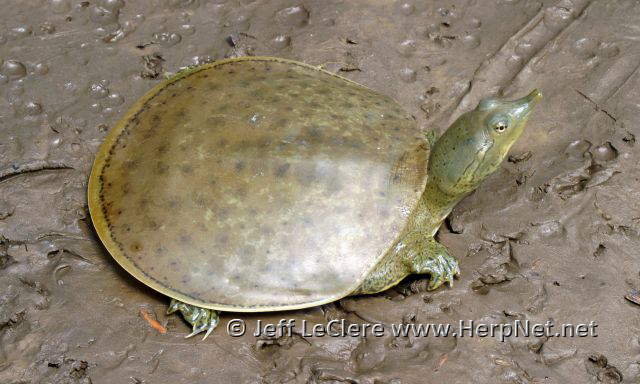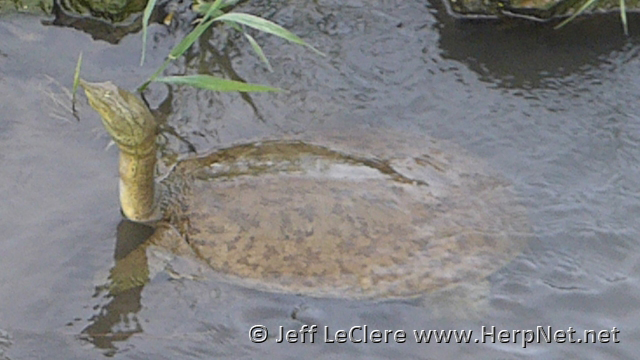Spiny Softshell (Apalone spinifera)
by Jeff LeClere
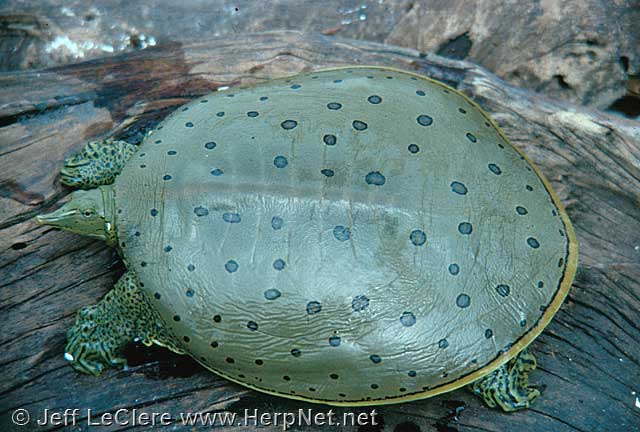
Status
Species of Greatest Conservation Need. LEGAL to take with a valid fishing license. These turtles may be trapped, taken by hand, hook and line, turtle hook throughout Iowa. The possession limit 100 pounds for live and 50 pounds for dressed turtles.
Description
The spiny softshell turtle is a large Iowa turtle and grows to a carapace length of 17 inches for females (Conant and Collins, 1991 ). Males reach only half that length. Softshells are most easily recognized by the appearance of their carapace. It does not have the the bony scutes of our other turtles. Instead, it is flat and leathery with very flexible edges. It very much resembles a pancake.
In adult males, the entire shell feels like sandpaper. In adult females, the shell may be smooth, but there are several large spines or cone-like projections at the front of the carapace. The nose tapers to a point and resembles a snorkle. There is a ridge in each nostril. Adult males are usually more yellowish or greenish in overall coloration and the shell is covered with numerous ocelli (dark circles). Adult females are much more drab in coloration and the ocelli break up and become large dark blotches on the carapace. Both sexes have two lines on the side of their head; one behind the eye and one that starts under their snout. The neck and feet are strongly patterned with yellow and black.
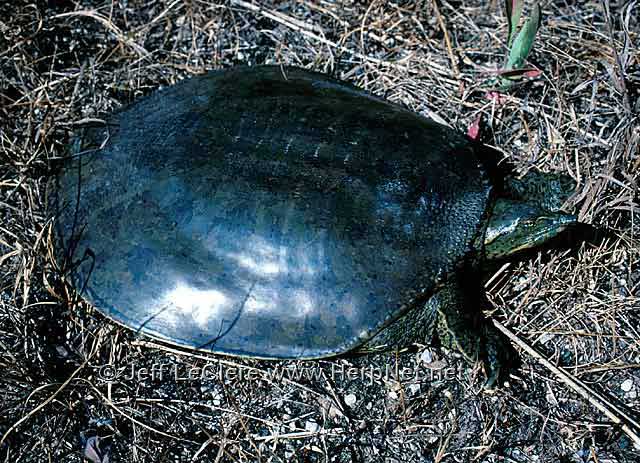
Their feet have extensive webbing – much more than any other Iowa species. The plastron is quite small and white with no distinctive markings. Males have a long, thick tail with the opening near the tip. Females have tails so short, that they barely extend past the edge of the carapace and have the opening higher up. The young are about two inches at hatching and are patterned with dark spots or circles like adult males. Their shells are smooth the first couple years of life.
Subspecies
There is one subspecies found in Iowa, the eastern spiny softshell, Apalone spinifera spinifera. Formerly, an additional subspecies, the western spiny softshell, Apalone spinifera hartwegi, was listed as occurring in Iowa. The western subspecies has been synonymized with the eastern subspecies as is no longer recognized.
Range
The spiny softshell is found in suitable habitat throughout Iowa. The only areas lacking records at this time are northwestern Iowa (Christiansen and Bailey, 1991)
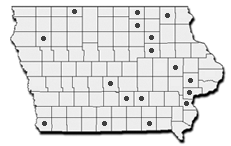
Habitat
Spiny softshells are found in rivers, streams, and large lakes with sandy or muddy bottoms. Sandbars are important for basking and egg laying sites.
Habits
These turtles are active from April and to late September and October. They bury themselves in mud or sand at the bottoms of rivers or lakes. They are diurnal and sleep at night underwater buried in sand or mud in the shallows or among submerged trees. They are one of Iowa’s most aquatic turtle species. They bask on sand or mud bars or on large logs and rocks, but always at the water’s edge. They are wary and will quickly dash into the water at the slightest disturbance.
They are the fastest swimmers of Iowa’s turtles. If picked up, they will bite and scratch with vigor; the only way to safely handle a large specimen is to grasp them by the base of the hind legs or the posterior edge of the shell. Make sure the turtle is held away from, and faces away from, one’s body. Sometimes they rest buried in the sand in shallow water. They extend their necks and use their long noses as snorkels. They hunt during the day. Softshells can remain submerged for up to five hours using either dermal or cloacal respiration (Dunson, 1960). However, softshells usually do not remain submerged for more than 20 minutes while active (Stone et al, 1992b). They are capable of exchanging gas through their skin in both water and air. The smooth skin of softshell turtles are three or four times as permeable as other hard shelled turtles (Bentley and Schimdt-Nielson, 1970).
Spiny softshells breed in May and they lay their eggs in June or July. Females usually dig nests on sand bars that receive sunlight. This location is closer to the water than Iowa’s other turtle species, so many females are not observed (and killed) on their way to lay the 12 to 30 eggs. Carnivorous mammals, however, dig up most of the nests and eat the eggs. The brittle shelled eggs are the shape of, and a little smaller than, ping-pong balls.
The young hatch in August or September. Hatchlings overwintering in the nests have not been observed in Iowa. The young are patterned like adult males, and have upturned noses and the sides of the carapace droop covering the hind limbs and tail like a blanket. Hatchling softshells are eaten by a variety of carnivorous vertebrates including large fish.
Food
Spiny softshells are mainly carnivorous, feeding on almost any aquatic life of appropriate size. Reports on stomach contents of spiny softshells from different states have found that the number one food item consumed may be different for each state, although generally the same items have been recorded. Spiny softshells in Iowa consumed mostly aquatic plants followed closely by crayfish (Williams and Christiansen, 1981). Breckenridge (1944) lists crayfish, aquatic insects, and fish as food items. I have observed a large female spiny softshell eating a crayfish near the shore of the Upper Iowa River in Winneshiek County. It used its front limbs to tear the crayfish apart and swallowed the pieces.
